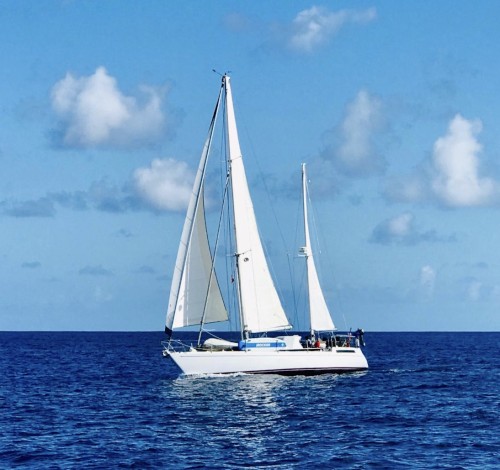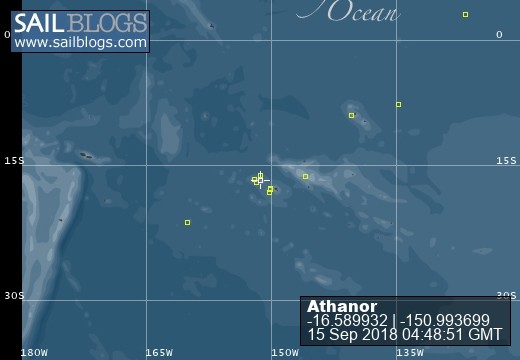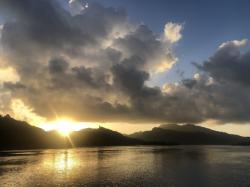Marquesas Wrap

We haven’t written in awhile – too long. We’ve still got our training wheels on!
When we last wrote (6/3), we were departing Nuku Hiva for the Tuomotos, with several stops in between. We had a great sail from Nuku Hiva to our first stop, Ua Poa, which was a surprising gem. Approaching from the north, the island has a very dramatic visage consisting of tall spires that reach up into the clouds that typically sit overhead. We anchored off the Hakahau village in a small – and unbelievably rolly (= “uncomfortable”) anchorage. The village, however, was quite something. As we walked through town, we loved that, in every aspect, it was so “cared for.” Now that we’ve spent time on several islands and in several villages – all are subsidized by the French government – we’re noticing that each has it’s own distinct energy and feel, and attention paid to the surroundings. Susan couldn’t help but wonder if this community came together to request more funding from France to improve their village. Whilst strolling about, we met the “mayor” of the island, Joseph, who talked with us at length about the history of the relationships between the various islands; specifically how they used to operate very separately, and now they are coming together to reclaim the deep culture and Marquesan traditions that they share. As we said goodbye, he sent us on our way with several fresh mangos from his trees.
Attending church in Ua Poa is one of the most memorable experiences for me thus far. Susan and I put on our most “presentable” clothes; we dinghied ashore at 7a.m., hauled the dinghy up on the beach, and walked a mile into town. As we neared the church, we began to see what felt like the entire village making their way toward the church – young, old, on foot, in cars, in strollers – all dressed in their Sunday best. As we entered this exquisite open-air building, our senses were pleasantly heightened. The church was filled with 400 people! The women, in particular, were in bright, colorful, and well tailored dresses. All wore their hair “up,” and most were adorned with sweet smelling flowers that filled the air. The men, too, were well dressed, some in long dress pants and button up shirts, but also many in shorts and sandals. We saw families, extended families, and many women attending with their children. Watching the children throughout the service was particularly fun, as they made faces at us and other kids -- a kind of subtext to the main service which was spoken in a combination of French, Marquesan, and Latin , and none of which we understood. The alter attendants were all bare footed, as was the priest. A dour older French male, never smiling, he embodied the stereotypical image of a catholic priest. In stark contrast, the Marquesan singing nearly brought us to tears. Susan discreetly captured an audio recording on her phone.
Amidst the splendor of Ua Pou, and as we waited for the next weather window to the Tuomotus, we were debating what to do about some issues we’d been having with our batteries. Since we rely heavily upon these batteries as the backbone of our electrical system, it seemed prudent to address this while we still had access to services and before we headed for more remote places. Reluctantly, we decided to return to Taiohae Bay to tackle the problem. We rented a portable generator and spent three days giving our batteries a deep charge. Ultimately, we were satisfied that the batteries would carry us for another couple of months, and ordered four new batteries to be shipped form the US to Papeete for delivery when we arrive there in mid-August. We’ve read many times from cruisers….cruising is simply working on your boat in exotic places!
On June 11th, we headed south on an overnight sail for Tahuata, where we planned to spend Susan’s birthday. We anchored in one of our favorite anchorages – Hanamanoe Bay. It’s quite nice to have been in the Marquesas long enough that we have the privilege to “return” to a favorite anchorage! We were in the company of three boats that had just arrived from the Galapagos – two from Norway, and Jonas, a single-hander from Sweden – plus “Scoots,” a 50’ Able Apogee that was also on the Puddle Jump with us from Mexico. For Susan’s birthday, we invited folks from all the boats over for Pamplemoose and Mango cocktails. The Norwegians regaled us with stories of their month-long stay in Cuba and, upon hearing that Susan’s grandmother came to the US from Norway, sang Happy Birthday to Susan in Norwegian! The next morning, Friday, we weighed anchor at daybreak and motored five miles over to Hiva Oa to spend a day stocking up on food and diesel prior to heading to Fatu Hiva. Early Saturday, we departed Hiva Oa for Fatu Hiva, a day sail of approximately 35 miles south, the last island we would visit in the Marqueses.
Entering the “Baie de Viergens” (Bay of Virgins) in Fatu Hiva is the most dramatic of all the islands in the Marquesas. A note of history: This bay was originally – and aptly - named “Baie de Vergens” (Bay of Penises). The pillars at the entrance of the bay can only be described as phallic looking. You can imagine how quickly the Catholic missionaries addressed that issue! With nothing more than inserting a small “i” – Voila! the bay became “Baie de Viergens.” All was right with the world. This magical and mysterious bay is surrounded by cliffs pounded relentlessly by the surf. The anchorage is very deep, and surrounded by tall and majestic cliffs, with steep columnar outcroppings. When we arrived, five boats were already anchored in this small bay with the best places for anchoring already taken. We had heard multiple stories of high winds, with boats dragging anchor and floating out to sea, so we had a fair bit of anxiety when we anchored in 90 feet of water! With a minimal 3:1 scope, we had almost all of our 300’ of chain out and little left for an emergency. Luckily the holding was in mud and quite good, even as 30+ knot gusts roared down from the mountain above. We didn’t sleep much. We stayed on the boat much of the time, mostly due to rain and the high wind gusts (and not wanting to leave the boat unattended), but did make it ashore a couple of times to explore the local village Hanavave. Locals were very generous in offering us various fruits and we arrived back at the dinghy with two bags full of pamplemouse, limes, oranges, bananas, and even some basil! On our first shore visit, Susan noticed a group of young women playing soccer, so she jumped at the chance to make sure they had a new, Wilson, soccer ball! Joy!
Our time in Fatu Hiva was shorter than we liked but, after three days, our weather data (watching the weather is a HUGE part of our daily lives!) showed that we had a short weather window that we could take for our passage to the Tuomotus or we could stay and wait a week or more for the next window. We decided that we would make a run for it, hoping for a fast and relatively easy sail down to the Tuomotus. Reflecting now, all throughout tour travels in the Marquesas, we thought about Fatu Hiva as leaving the best for last. As we’ve written in prior posts, we’ve tried to be very conscious of “staying before leaving”, and realize now that we missed that opportunity in Fatu Hiva. A lesson learned.
Our departure from the Marquesas Islands was an emotional one. We fell in love with this rugged, mystical, never heard of place! It is where we made our first landfall – where our journey in the South Pacific began. We will miss you Marquesas.
When we last wrote (6/3), we were departing Nuku Hiva for the Tuomotos, with several stops in between. We had a great sail from Nuku Hiva to our first stop, Ua Poa, which was a surprising gem. Approaching from the north, the island has a very dramatic visage consisting of tall spires that reach up into the clouds that typically sit overhead. We anchored off the Hakahau village in a small – and unbelievably rolly (= “uncomfortable”) anchorage. The village, however, was quite something. As we walked through town, we loved that, in every aspect, it was so “cared for.” Now that we’ve spent time on several islands and in several villages – all are subsidized by the French government – we’re noticing that each has it’s own distinct energy and feel, and attention paid to the surroundings. Susan couldn’t help but wonder if this community came together to request more funding from France to improve their village. Whilst strolling about, we met the “mayor” of the island, Joseph, who talked with us at length about the history of the relationships between the various islands; specifically how they used to operate very separately, and now they are coming together to reclaim the deep culture and Marquesan traditions that they share. As we said goodbye, he sent us on our way with several fresh mangos from his trees.
Attending church in Ua Poa is one of the most memorable experiences for me thus far. Susan and I put on our most “presentable” clothes; we dinghied ashore at 7a.m., hauled the dinghy up on the beach, and walked a mile into town. As we neared the church, we began to see what felt like the entire village making their way toward the church – young, old, on foot, in cars, in strollers – all dressed in their Sunday best. As we entered this exquisite open-air building, our senses were pleasantly heightened. The church was filled with 400 people! The women, in particular, were in bright, colorful, and well tailored dresses. All wore their hair “up,” and most were adorned with sweet smelling flowers that filled the air. The men, too, were well dressed, some in long dress pants and button up shirts, but also many in shorts and sandals. We saw families, extended families, and many women attending with their children. Watching the children throughout the service was particularly fun, as they made faces at us and other kids -- a kind of subtext to the main service which was spoken in a combination of French, Marquesan, and Latin , and none of which we understood. The alter attendants were all bare footed, as was the priest. A dour older French male, never smiling, he embodied the stereotypical image of a catholic priest. In stark contrast, the Marquesan singing nearly brought us to tears. Susan discreetly captured an audio recording on her phone.
Amidst the splendor of Ua Pou, and as we waited for the next weather window to the Tuomotus, we were debating what to do about some issues we’d been having with our batteries. Since we rely heavily upon these batteries as the backbone of our electrical system, it seemed prudent to address this while we still had access to services and before we headed for more remote places. Reluctantly, we decided to return to Taiohae Bay to tackle the problem. We rented a portable generator and spent three days giving our batteries a deep charge. Ultimately, we were satisfied that the batteries would carry us for another couple of months, and ordered four new batteries to be shipped form the US to Papeete for delivery when we arrive there in mid-August. We’ve read many times from cruisers….cruising is simply working on your boat in exotic places!
On June 11th, we headed south on an overnight sail for Tahuata, where we planned to spend Susan’s birthday. We anchored in one of our favorite anchorages – Hanamanoe Bay. It’s quite nice to have been in the Marquesas long enough that we have the privilege to “return” to a favorite anchorage! We were in the company of three boats that had just arrived from the Galapagos – two from Norway, and Jonas, a single-hander from Sweden – plus “Scoots,” a 50’ Able Apogee that was also on the Puddle Jump with us from Mexico. For Susan’s birthday, we invited folks from all the boats over for Pamplemoose and Mango cocktails. The Norwegians regaled us with stories of their month-long stay in Cuba and, upon hearing that Susan’s grandmother came to the US from Norway, sang Happy Birthday to Susan in Norwegian! The next morning, Friday, we weighed anchor at daybreak and motored five miles over to Hiva Oa to spend a day stocking up on food and diesel prior to heading to Fatu Hiva. Early Saturday, we departed Hiva Oa for Fatu Hiva, a day sail of approximately 35 miles south, the last island we would visit in the Marqueses.
Entering the “Baie de Viergens” (Bay of Virgins) in Fatu Hiva is the most dramatic of all the islands in the Marquesas. A note of history: This bay was originally – and aptly - named “Baie de Vergens” (Bay of Penises). The pillars at the entrance of the bay can only be described as phallic looking. You can imagine how quickly the Catholic missionaries addressed that issue! With nothing more than inserting a small “i” – Voila! the bay became “Baie de Viergens.” All was right with the world. This magical and mysterious bay is surrounded by cliffs pounded relentlessly by the surf. The anchorage is very deep, and surrounded by tall and majestic cliffs, with steep columnar outcroppings. When we arrived, five boats were already anchored in this small bay with the best places for anchoring already taken. We had heard multiple stories of high winds, with boats dragging anchor and floating out to sea, so we had a fair bit of anxiety when we anchored in 90 feet of water! With a minimal 3:1 scope, we had almost all of our 300’ of chain out and little left for an emergency. Luckily the holding was in mud and quite good, even as 30+ knot gusts roared down from the mountain above. We didn’t sleep much. We stayed on the boat much of the time, mostly due to rain and the high wind gusts (and not wanting to leave the boat unattended), but did make it ashore a couple of times to explore the local village Hanavave. Locals were very generous in offering us various fruits and we arrived back at the dinghy with two bags full of pamplemouse, limes, oranges, bananas, and even some basil! On our first shore visit, Susan noticed a group of young women playing soccer, so she jumped at the chance to make sure they had a new, Wilson, soccer ball! Joy!
Our time in Fatu Hiva was shorter than we liked but, after three days, our weather data (watching the weather is a HUGE part of our daily lives!) showed that we had a short weather window that we could take for our passage to the Tuomotus or we could stay and wait a week or more for the next window. We decided that we would make a run for it, hoping for a fast and relatively easy sail down to the Tuomotus. Reflecting now, all throughout tour travels in the Marquesas, we thought about Fatu Hiva as leaving the best for last. As we’ve written in prior posts, we’ve tried to be very conscious of “staying before leaving”, and realize now that we missed that opportunity in Fatu Hiva. A lesson learned.
Our departure from the Marquesas Islands was an emotional one. We fell in love with this rugged, mystical, never heard of place! It is where we made our first landfall – where our journey in the South Pacific began. We will miss you Marquesas.








Comments